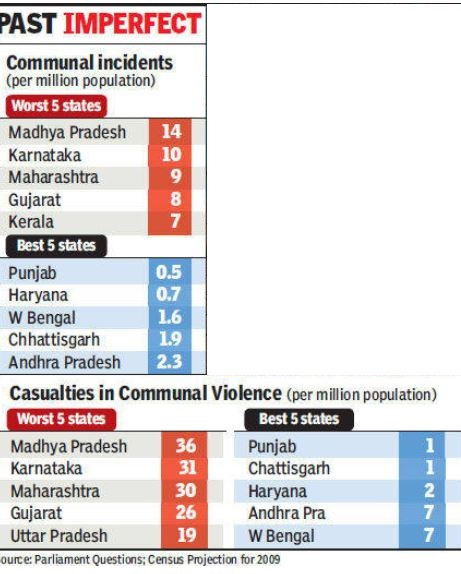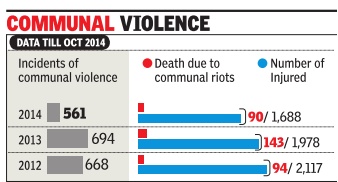Communal clashes, riots, hate crimes: India

This is a collection of articles archived for the excellence of their content. Readers will be able to edit existing articles and post new articles directly |
Contents |
Clashes between religious groups: 2005-13
1,000 communal clashes, 965 dead in last 8 years
Subodh Varma, TNN | Sep 20, 2013
NEW DELHI: In 2005-2013, there have been nearly a thousand communal incidents across the country. While the casualties are countable - 965 dead and over 18,000 injured - the toll on India's economic and social fabric is beyond any metric.
More than half of these incidents took place in five states -- Madhya Pradesh, Karnataka, Maharashtra, Gujarat and Kerala. While Uttar Pradesh is generally considered to be the most susceptible to communal tensions, if incidents of communal violence and casualties are measured in the context of the population of states, a different picture emerges.
The worst five states in India in terms of communal incidents per million population are Madhya Pradesh, Karnataka, Maharashtra, Gujarat and Kerala, in that order, over a period spanning from 2005 to the first quarter of 2013. Madhya Pradesh, with 965 incidents between 2005 and 2013 (March), has the worst record of nearly 14 incidents for every million population. The countrywide average is about 5 incidents per million population. This is because in most parts of the country communal strife is negligible.
Uttar Pradesh, by this reckoning, has a count of about 5 incidents per million population, similar to the national average, while its neighbour Bihar, once considered a hotspot of communal violence, has just 2.8 incidents per million. Andhra Pradesh, Chhattisgarh, West Bengal, Haryana and Punjab are the five best states with communal incidents at less than 2 per million population.
Data for communal incidents was culled from answers given by the home minister to several Parliament questions.
Casualty figures for communal incidents, including both the number of persons killed and injured, are almost in direct correspondence to the number of incidents, barring a major exception, Uttar Pradesh. This state joins the ranks of the worst five states in terms of casualties in communal violence with Kerala dropping much further down. Madhya Pradesh again leads with 36 casualties per million population. The all-India average is just over 16.
The five best states in terms of lowest casualties in communal violence are Andhra Pradesh, West Bengal, Chhattisgarh, Haryana and Punjab. The first two have about 7 casualties per million, while the other three have less than 2 per million population.
Casualties reflect the extent and nature of violence in an incident. Muzaffarnagar is one of the worst incidents in recent years. The Gujarat killings in 2002 were by far the most extensive and brutal in the new millennium, with estimates of those killed varying between 1,000 and 2,000.
Riot victims: religion-wise data for Jan-Sep 15, 2013
Government releases data of riot victims identifying religion
PTI | Sep 24, 2013
A document released by the home ministry said there were 479 riots in the country, including in Muzaffarnagar in Uttar Pradesh, till September 15, 2013, in which 107 people lost their lives.
NEW DELHI: Perhaps for the first time, the home ministry has identified the religion of victims of communal violence, saying 107 people lost their lives in riots between Jan 1-Sep 15 2013, of whom 66 were Muslims and 41 were Hindus.
A document released by the home ministry said there were 479 riots in the country, including in Muzaffarnagar in Uttar Pradesh, till September 15 in which 107 people lost their lives.
UP recorded the highest number of casualties — 62 — among all states, of whom 42 were Muslims and 20 were Hindus. There were 93 riots in UP in the first nine months of 2013 in addition to 108 incidents of tension in the state.
Altogether 1,697 people were injured in communal disturbances in the country this year, of whom 794 were Hindus and 703 were Muslims. Among the injured this year, there were 200 policemen.
A total of 219 Muslims and 134 Hindus were injured in riots in Uttar Pradesh in 2013.
Bihar, which saw 40 communal disturbances and 25 incidents of tension-like situation in 2013, recorded nine death in riots, of whom five were Hindus and four were Muslims. Among the injured in Bihar, 123 were Hindus and 66 were Muslims, while 19 were from the police department.
In Gujarat, there were 54 cases of communal violence and 21 of tension in 2013 in which six people lost their lives of whom three each were Hindus and Muslims. Of the injured in Gujarat, 85 were Hindus, 57 Muslims and five were police personnel. There were 56 communal disturbances and 100 incidents of tension in Maharashtra this year, in which three Hindus and seven Muslims were killed. Of the injured, 101 were Hindus, 106 Muslims and 64 policemen.
2012-June 2014
No sharp rise in clashes since NDA-2 took over
Bharti.Jain@timesgroup.com The Times of India Aug 07 2014
The charge in Lok Sabha that incidents of communal violence had increased since the NDA took over is not quite backed by data maintained by the home ministry. A comparison of monthly average of communal incidents reported from across the country in the last couple of years and during May-June 2014, after the Modi government assumed office, shows that incidents per month fell to 56.5 during MayJune 2014 from 68.6 in 2013. The 2012 average, though, was better at 55.7 incidents per month.
Similarly, the average number of deaths and injured on account of communal incidents was lower at 7.5 and 159 per month respectively over May-June this year, compared to 11 deaths and 189 injured per month in 2013 and 7.8 deaths and 176.4 injured in 2012.
In absolute terms, 133 persons were killed and 2,269 injured in a total of 823 incidents of communal violence in 2013, while the figures in 2012 were 94 deaths, 2,117 injuries and 668 in 2012. However, as per tentative figures for May-June 2014, 15 persons were killed and 318 injured in 113 incidents across the country.
However, experts warned that the comparison based on monthly average for just two months of May and June 2014 and that for entire 2013 and 2012 may not be perfect, as incidents could see a rise or fall in the coming months. It was felt that a comparison between communal violence figures for the latter half of 2014 and the corresponding period of 2013 would offer a better picture.
A state-wise break-up of the data compiled so far puts Uttar Pradesh at the top of the table in terms of monthly average, with 3.25 deaths, 41.7 injured and 9.8 incidents per month in 2012 and 6.4 deaths, 30 injured and 20.6 incidents per month in 2013. In MayJune 2014, the average worked out to 3 deaths, 39 injured and 13.5 incidents per month.
2012–October 2014
Riot rate dipped in 2014, Rijiju tells Parliament
Bharti Jain The Times of India The Times of India Nov 27 2014
Incidents of communal violence have declined to 561 between January and October this year from 694 and 668 in the corresponding period of 2013 and 2012. The number of those killed in communal riots dipped from 143 (tentative figure cited in reply to a Lok Sabha question dated December 10, 2013) until October last year to 90 over the same period this year. The corresponding figure for 2012 was 94 deaths.
Similarly , the number of those injured until October this year stood at 1,688 as compared to 1,978 (as per data placed in Parliament on December 10 last year) and 2,117 during the corresponding period of 2013 and 2012 respectively .
Minister of state for home Kiren Rijiju, while replying to a Rajya Sabha question on Wednesday seeking details of communal incidents in the current year, attributed the 561 incidents, 90 deaths and 1,688 injuries until October 31 this year to “religious factors, genderrelated issues, land and property disputes and other miscellaneous issues“.
The higher casualty on account of communal riots during 2013 may be attributed to the violent clashes that broke out in Muzaffarnagar in August-September.
Jan –May 2015: Communal clashes

The Times of India, Jul 22 2015
Communal clashes up 24% in Jan-May 2015
Up To 287 From 232 In Same Period Last Yr Communal violence in India has registered a jump with incidents rising by 24% and related deaths too up by 65% in the first five months of 2015 as compared to the corresponding period of last year, when the UPA government was in the saddle. As per latest data collated by the Union home ministry , 287 communal incidents were reported from across the country this year until May 31, as compared to 232 over the same period in 2014.
Deaths due to communal clashes during January-May 2015 rose to 43 from 26 and the number of injured too were higher at 961 from 701 in the first five months of last year.
The states that reportedly accounted for a major portion of the increase in communal clashes were Uttar Pradesh, Haryana, Maha rashtra and West Bengal.
This is for the first time that data has reflected negatively on the state of communal harmony under the Modi government.
Earlier, a comparison of the annual data for the year 2014 and 2013 had shown a fall in incidents to 644 from 823 respectively .
Deaths in 2014 too dipped to 95 from 133 and injured were fewer at 1961 as compared to 2,269 in 2013.
Many argued that the lower communal violence in 2014 as compared to 2013 was not really a verdict on the effectiveness of Modi government to control riots, considering that UPA was in power until mid-May 2014.


